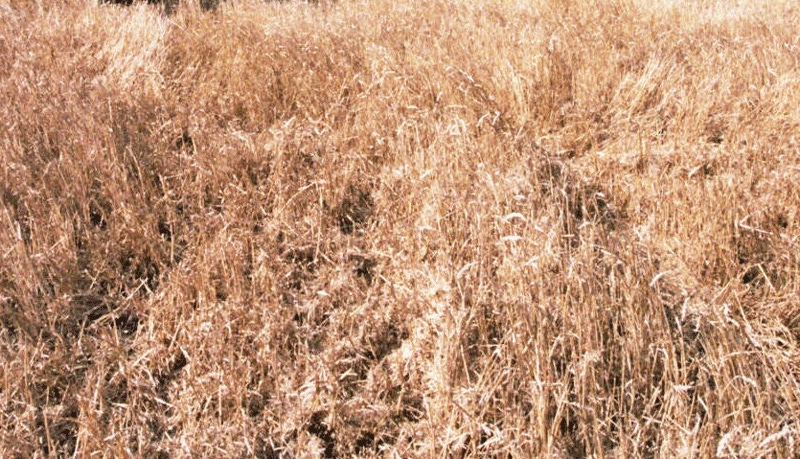July 7, 2011

Baling wheat straw has become a more common practice in the past few years for many reasons, said Fabian Fernandez, University of Illinois Extension specialist in soil fertility and plant nutrition.
While the uses for wheat straw are varied, removing straw has at least one common denominator: exporting nutrients out of the field.
“Knowing how much nutrient is contained in straw is important,” Fernandez said. “It helps producers know the value of the straw, in addition to how much fertilizer is being removed, or in other words, how much fertilizer should be applied back to the field to maintain fertility levels.”
He said the most precise way to determine how much fertilizer is being removed with the straw is to obtain the weight of the bales and to extract a representative sample of the straw. Using that sample, two values must be obtained from a testing lab — moisture content to determine the dry weight of the bale and nutrient content of the sample reported on a dry basis.
“This approach may not be practical or possible for all producers,” he added.
“If that is the case, then it is possible to estimate the value of straw by following a few simple steps. But keep in mind that this second approach is an estimate and there can be substantial variability depending upon how the straw is processed.”
The first step in the calculation is to determine how much straw is being produced. The best estimates are obtained as a function of plant height and grain yield.
Estimates vary
These estimates vary somewhat, but a typical value is close to 1 pound of straw per pound of grain, he said.
In this step, remember that a bushel of wheat is 60 pounds, but there are 8.1 pounds of moisture (a 60-pound bushel of wheat contains 13.5 percent moisture).
So a bushel of wheat is 51.9 pounds of dry grain. The dry grain yield in bushels per acre is multiplied by 51.9 and then divided by 2,000 to obtain the number of dry tons of straw produced.
The second step in the calculation is to determine how much straw is actually removed. Again, this is not an absolute value because it will depend on cutting height and how much of the cut straw is actually baled.
In general, a good wheat crop yields about 2.5 to 2.8 tons of straw per acre on a dry matter basis, Fernandez said.
The third step in the calculation is to know the nutrient content of the straw. As a guide, a ton of wheat straw normally contains 9 to 12 pounds of nitrogen (N), 3 to 4 pounds of phosphorous (P) in the form of P2O5, and 25 to 45 pounds of potassium (K) in the form of K2O.
“The large variability in K content arises from the fact that K is not incorporated into organic compounds, allowing K to easily be leached out from the residue,” he said.
“The time elapsed, the amount and the frequency of precipitation since the crop reached maturity and the time the straw is removed from the field will impact how much K there is.”
Typically, K leaching occurs rapidly. It is not unusual to see a decrease in K content of as much as 80 percent after the straw has been rained on a few times.
On the other hand, N and P contents in the straw are more or less stable because they are present in organic forms and require microbial decomposition of the straw before they can be leached out, Fernandez said.
The fourth and final step in the calculation is to determine the fertilizer value. This is done by using the above information and the current price of fertilizer to obtain a value of dollars per acre.
“Removal of major nutrients (N, P, K) is just one of the costs associated with straw removal, but there are other costs that might not be easily observed in the short-term, but can have important impacts on future productivity of a field,” he said.
In addition to the major nutrients, wheat straw also contains calcium (Ca), magnesium (Mg), sulfur (S), and micronutrients. In Illinois, the soil native supply of these additional nutrients is typically high, so Fernandez said there is no need to supply these nutrients through fertilization.
Greater removal of these nutrients by harvesting straw can accelerate depletion rates and result in deficiencies in the future.
“Removal of basic cations, like K, Ca, and Mg, can lead to an increase in the need to lime soils to maintain adequate pH levels,” Fernandez said. “Depletion of organic matter and N reserves can lead to less crop availability of N through the process of mineralization. Diminishing organic carbon contents can also result in negative impacts on soil conservation and on soil physical, chemical, and biological properties. It’s important to consider all of these factors when estimating the true cost of straw removal.”
For more information, read the July 7 edition of The Bulletin online at http://bulletin.ipm.illinois.edu/.
You May Also Like




